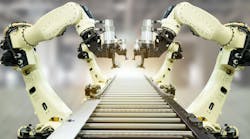There’s a reason why so many manufacturers have turned to machine vision for decades now. Simply put, vision technology is a thing of beauty with its ability to consistency and accurately handle the tedious and repetitious task of visually finding errors. However, not all vision systems are created equally. After all, there are meaningful differences between the traditional “set it and forget it” vision systems and those with deep learning capabilities.
"We're only at the very beginning of this revolution with huge potential for AI to help manufacturing," says Dr. Amy Wang, co-founder and vice president of systems at AI-enhanced machine vision company, Cogniac. Cogniac’s system combines the latest AI research, human-computer interaction tools, and large-scale data management to make computer vision easier, more accurate and scalable, enabling manufacturers to extract information from ever-increasing image data and video streams.
Selecting ideal applications
A huge step function in what's possible to automate with deep learning exists – things not at all possible before. However, putting an AI system into an existing process and expecting it to work could lead to disappointment. “There are usually process changes to take full advantage of the deep learning capabilities. AI needs to be driven by data – meaning people need to label images. You want to pay attention to data, you want to gather data, you want to use this data to the fullest advantage,” she says.
Cogniac addresses the necessary changes by first understanding the workflow – from the parts coming in to the various indicators the company considers defects – in order to design an effective solution that is ready to learn and improve. “Dedicated subject matter experts, the people who know what they're looking for, play a crucial role in labelling images to create good models,” says Wang. “The level of commitment to managing the change process from the beginning makes or breaks a project.”
The typical workflow should start with identifying a business problem, uploading images into the system, labelling a small set of data, and then allowing the system to start training the model automatically. “Along the way, operators can see what the model is doing, and make adjustments as needed,” she says. “For example, if somehow you see the defect, the lighting is not right, or the camera angle is not right, you can adjust your cameras. You can adjust your business priority about what actions you want to go after.”
Case in point? Cogniac has a customer inspecting 7 foot x 10 foot panels coming down the line every four seconds. It needs to identify very small defects like very small split or dings on the on the panel. “We have 25 high resolution cameras taking snapshots as it comes down the conveyer belt,” she says. “Those images are fed into the system and applied to the model. The splits could be anywhere on the panel and it can be any shape. The variability is quite large, sometimes they are very tiny splits. The system noticed issues the company did not even recognize initially, enabling them to modify quality priorities.”
Wang tells IndustryWeek, by watching the images coming in, the Cogniac system’s model can is make predictions about those images. If the model is not confident because of something new (i.e. a material or environmental change), the system will create an alert asking for help. “Helping the model through a change, makes the system learn and get better over time,” she says. “Our system has a very intuitive interface allowing users to create workflows for their inspections. We then have an AI assisted labeling to help subject matter experts label images. Once a company has a successful first application, it's almost addictive to find other opportunities. easy to do more with it.”
The key to being able to scale is to deploy trials within the production environment so that vision system is working off images that accurately align with production expectations.





